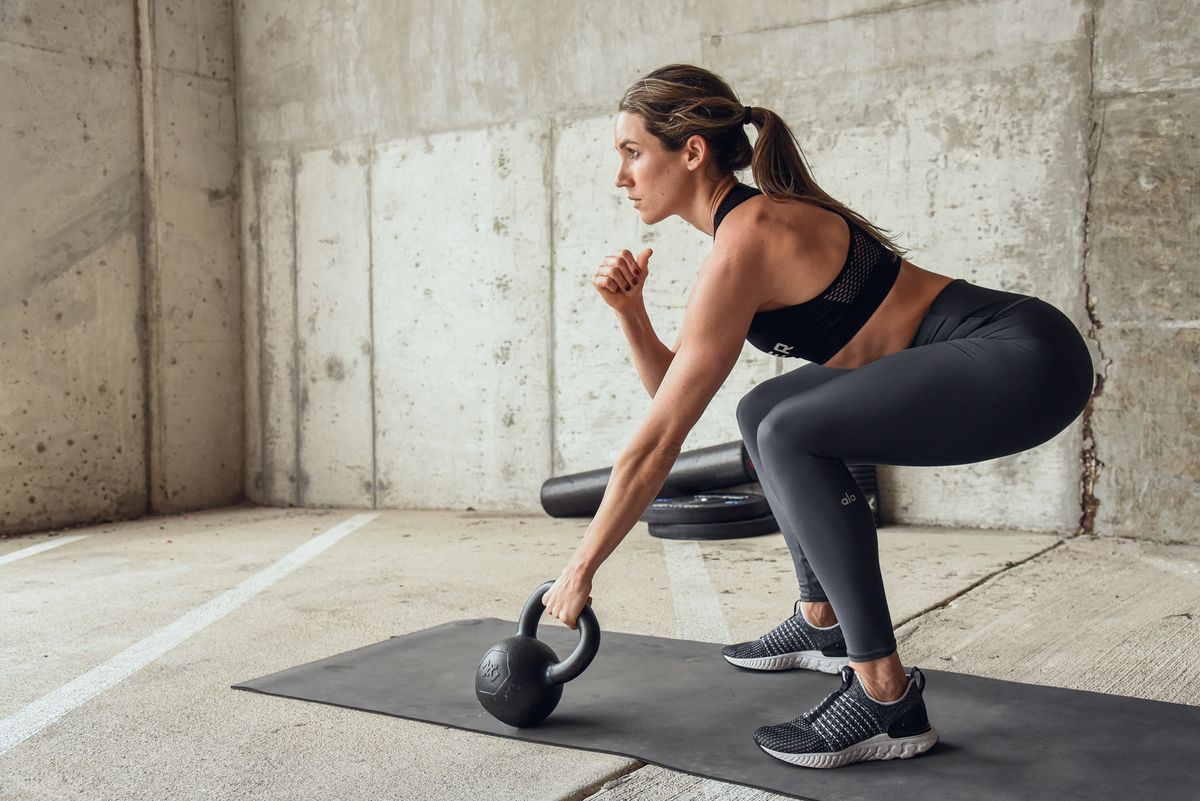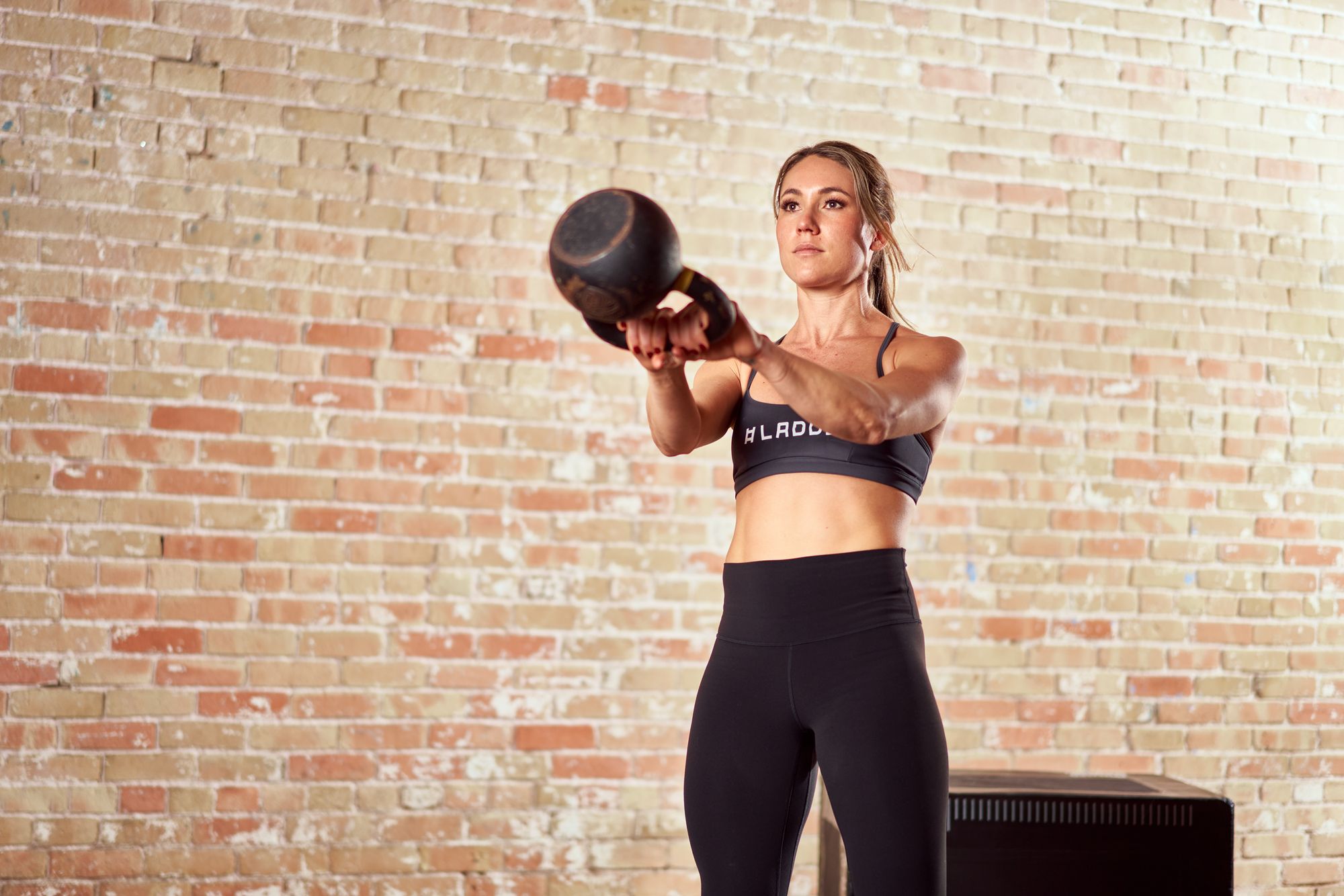How to Do a Kettlebell Swing? (with video demonstration)

Master the Kettlebell Swing Step-by-Step, and Avoid Common Mistakes and Injuries.

Lauren Kanski
Ladder Senior Coach, CPT

Kettlebell Swing Introduction
The kettlebell swing is a full-body explosive movement that develops power in your hips, strengthens your entire posterior chain, boosts your metabolism, and improves your overall athleticism.
In this article and in my video demonstration, I’ll show you how to properly perform the kettlebell swing and how to incorporate the swing into your workout routine and kettlebell training.
I’ll also share the benefits of the swing and help you avoid injury by showing you some of the common mistakes people make when learning the exercise.
Kettlebell Swing Demonstration (audio & video)
Step-by-Step Instructions for the Kettlebell Swing
Step 1: Create a Tripod
Take two foot length steps back from the kettlebell, bring your feet about shoulder-width distance a part. Reach both hands out in front of you, the horns of th kettlebell should be underneath your palms.
Step 2: The Hike Set-up
Hinge from your hips and bring your butt down towards the floor, keeping your shins vertical, and chest above your hips. Reach your arms out and grab the horns of the kettlebell, tilt it back towards you. Imagine you're pulling the horns apart and drag it towards you slightly, locking your lats in. Gaze is about 4 feet in front of you.
Step 3: The Hike Into First Swing
On an inhale, keep your butt down and throw the kettlebell back behind you like a football player hiking a football. With your arms gripping the bell, on an exhale, you’ll begin to thrust through your hips to swing the kettlebell forward. Follow the bell with your hips and come up to a standing plank position.
Step 4: Positioning at Top of the Swing
The kettlebell should swing up to about chest height. Keep your scapulas back, arms are straight out in front of you, elbows locked out, relax your shoulders and traps. Your gaze is straight ahead.
Step 5: Pause at the Top of the Swing
Stay as tall as possible while you let the kettlebell and your arms begin to fall back down towards your thighs. Inhaling as you pull the bell back behind your pelvis, do not bend in your hips and knees until right before the kettlebell makes contact with your thighs. Play “chicken” with the bell.
Step 6: Prepare for Another Swing
You’ll repeat all those steps again. The key with swings is to be explosive and then relax.
Kettlebell Swing Mistakes That Lead to Injury
Let's take a look at the most common mistakes people make when performing the kettlebell swing and talk about how to avoid them so you can perform this exercise safely and effectively.
Mistake #1:
Using your arms instead of your hips to swing the kettlebell. The kettlebell swing is all about momentum and driving your hips. Your arms are just straps. Keep arms straight, elbows locked out and let your hips do the work.
Mistake #2:
Hyper extending at the top of the swing (leaning back). You want to hit a tall standing plank position. Try to get your spine as long as possible. Drive your legs through the floor, squeeze your glutes and imagine drawing your ribs down to brace your core (like someone is going to punch you in the stomach) at the top of the swing.
Mistake #3:
Not being patient in the hinge, which makes it too knee dominant and “squaty”. On the contrary, being too patient and making it too “hingey” which loads your lower back and not your hip complex. Practice makes perfect!
Mistake #4:
Using a kettlebell that is too light! I’m not saying use the heaviest bell you have but we need to have some decent load to get our hips to work so our arms dont take over the swing.
Mistake #5:
Not starting with the kettlebell out in front of you. The hike position is the most important part of a swing. Imagine wanting to shoot a rubber band across the floor. The farther you stretch it, the farther it will go. BUT if you stretch too far, the rubber band will snap. Really understanding the tripod setup, activating the lats and pelvis positioning, keeping your hips down in the hike to load the hips is crucial.
The Benefits of the Kettlebell Swing
The kettlebell swing will help you increase your overall strength and endurance, enhance your ability to control your breathing under fatigue, build core strength and stabilize your body so that you can perform bigger and better lifts.
The ballistic loading of the swing creates an alternating cycle of muscular tension and relaxation. Being able to explode through your hips with max power and then completely turn them off is a skill, and one that all the best athletes in the world have in common. When running, jumping, or throwing something at max force and capacity, there is a period of max tension followed by complete relaxation so the muscle can regain energy for another contraction.
The swing is very low impact on the joints because there is no extreme loading or impact stress, which makes it extremely low risk for injuries when done with proper form.
How to Incorporate the Swing Into Your Workout Routine
The kettlebell swing is great for beginners who are newer to kettlebell workouts, but it is also an excellent exercise for advanced lifters who want to add some oomph to their workouts.
If you've just starting out with the kettlebell swing, it's important for you to take it slow. The best way to improve your form is to start with the basics and progress slowly.
It doesn't matter if you're using a light weight or heavy weight—it's always good form over speed. If you're new to kettlebells, I recommend starting with a weight that is no more than one third of your body weight, and on the flip side, make sure you're using enough weight so that it's challenging to keep control of the kettlebell on both the upward and downward movements.
Once mastered, the swing will serve as a great foundation for more complex kettlebell movements like the Turkish Get-up, the Windmill, and the Kettlebell Snatch.

Lauren Kanski
Ladder Senior Coach, CPT
Lauren is a Senior Coach at Ladder, a NASM-certified personal trainer, nutrition coach, Women’s Health Advisor, and published fitness writer based in New York City. Lauren’s online training program, BODY & BELL, available exclusively on the Ladder app, features daily full body workouts with a focus on kettlebell skills development and progressions.

